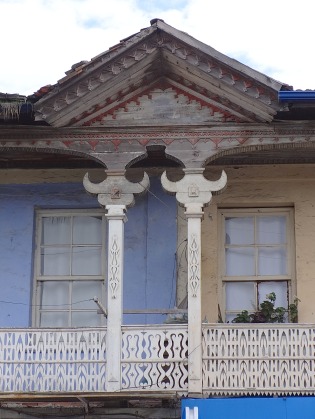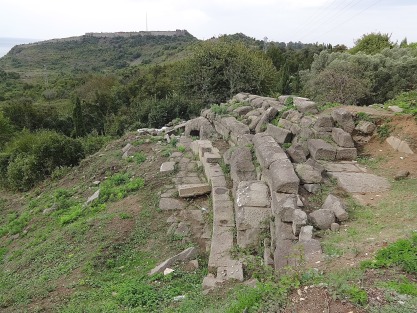Population: about 6,000
Old names: Billaeus, Tieion
On the map Filyos looks a mere hop and a skip from Zonguldak. In reality, however, it’s a very long and winding road that will get you to this forgotten corner of the Black Sea and while the wooded countryside is theoretically very beautiful what Man has done to it in the form of concrete urban development is certainly not. Midway there at Çatakağzı you will also be confronted by a power plant streaming pollution into the atmosphere.
Filyos itself is a small town on the waterfront that you are only likely to visit if you are a diehard enthusiast for ruins and want to tick off those of ancient Tios (Tion) high on the hillside east of town. Slight as they are, this is still the largest archaeological site to have been excavated on the coast.
In the town itself just one lovely wooden building of very distinctive appearance survives near the main bus stop. Sadly it’s mainly in use as an Aygaz shop. 
Around Tios
Most of ancient Tios lies on swampy ground near the mouth of the river Billaios which means that theoretically archaeologists could uncover most of it over time. The city was founded in the 7th century BC by colonists from Miletus as a port and trading post. It became part of the Roman Empire in 70 BC and later developed into a Byzantine episcopate. In 1261 the Genoese took the city which had fallen to the Ottomans by the start of the 15th century.
Driving up the hill you will see in a field to the left of the road the most substantial standing remains of what was probably an ancient bathhouse. Shortly after the slight remains of a Roman theatre are also visible to the left of the road together with three arches of an old aqueduct far away towards the vast factory that disfigures the view.
From the broken stone steps of the theatre you will be able to see Filyos Kalesi, a medieval castle ringing the hill ahead of you and sloping down towards the sea. A track on the left leads to the heavily restored walls and gate of the castle. Through it on the far side you’ll find the remains of a 2nd-century Roman temple almost side by side with a Byzantine church with a side chapel, said to date from the 8th to the 12th century.
On my last visit in 2014 visitors were not allowed to walk around these remains although signboards are in place and a ticket box ready so this may soon change.
A few finds from Filyos are on display in Karadeniz Ereğli Museum.
Sleeping
You are not likely to want to linger in Filyos. The best choice of hotels is in Zonguldak or Bartin.
 Transport info
Transport info
Buses to Filyos leave Zonguldak from neither the main terminal nor the chaotic local terminal in the town centre but from a separate bus stand near the huge and ugly Valilik building across the road from Türk Telekom. They are fairly infrequent so check times carefully.
Given that the journey is long, slow and windy you’re much better of taking a train from Zonguldak to Filyos instead, especially as Zonguldak station is in the town centre as is the one in Filyos. Trains are of the Raybus type with wide, comfortable seats and tables that fold down so that you can work on them with power points beside the seat. Prices are extremely reasonable and the view from the window (when you’re not in a tunnel) will be of a succession of reasonably attractive bays with dark sand beaches.
Infrequent buses continue from Filyos to Bartin for Amasra.


